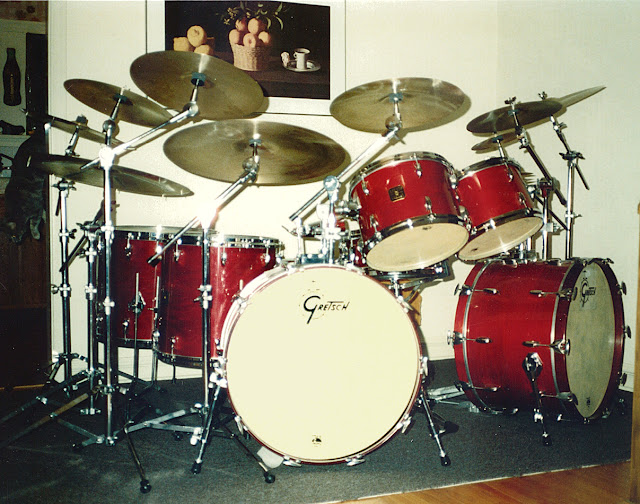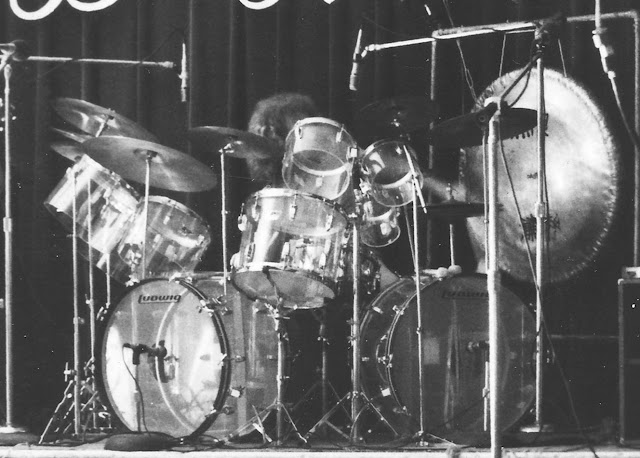My Drumsets, Part 4: Gretsch and Zildjian (1984 – 1990)
"Starting-from-scratch" drumset: Gretsch USA (red rosewood lacquer finish)
Configuration: Two bass drums, two small toms, two floor toms, snare drum
• Two 22” x 14” bass drums, 12” x 8” and 13" x 9" small toms, 16" x 16" and 18" x 16" floor toms, 14” x 5½” snare drum
• Pearl tom holders, snare stand & spurs; Yamaha cymbal stands; Rogers bass-drum pedals
• Nine brand-new A- and K-Zildjian
cymbals
After I sold my Vistalite drumset in 1982 and moved into a condo with my wife, things were good for the first couple of years, but then we began having marital issues. We saw a couple’s counselor and after we described what had been happening in our lives he asked me: "So tell me — who is Hyam?" I was shocked when I realized that I didn't have an answer for him! For the first time in my life I had lost my identity, and all at once it dawned on me that ever since that time as a 9-year old that I sat on the floor and marveled at Gene Krupa’s drumming on “Sing, Sing, Sing” (see Blame It All On Little Ricky), the true answer to his question had always been: "I am A Drummer!" By walking away from drumming I had unknowingly walked away from who I was as a person.
My wife was also having "condo issues", so she and I decided to move from our condo into a house so I could drum again and she could plant and tend a garden (which was becoming quite important to her). I invested a sales bonus into what would be the only ‘100%-everything-brand-new all-at-once’ drumset I’ve ever owned in my life. All my other drumsets before and since have included cymbals and some hardware that were carried-over from previous drumsets.
Although Japanese drum brands were taking over the professional-drum market by the mid-1980s, I didn’t care for the sound of the Japanese drums (Pearl, Tama, and Yamaha) — and I still don’t. Although well-made, I always thought that the sound of their drums lacked individual character. (They’ve always struck me as sounding like generic ‘McDrums’.) However at that time those three brands’ hardware (stands and holders) was the best in the world — strong, reliable and adjustable to suit almost any conceivable setup.
So I decided to buy American drums and Japanese hardware, and Gretsch was the best-quality drum being made in the USA at the time. By 1984 Slingerland & Rogers were pretty much out of business, and in that year Ludwig had moved their production from their original factory in Chicago to a brand-new factory in North Carolina, so their quality control at that point in time was not yet up to speed. Plus, I was influenced by the drum-shop owners, who catered mostly to L.A. studio players, Gretsch being a long-time favorite of studio drummers. I really liked the sound and the feel of the Gretsch drums I tried out in the drum shop — they were warm and woody sounding with plenty of character, and their response seemed to invite the sticks into the drumheads. I decided to order a brand-new Gretsch drumset in my preferred 2 bass drums/2 small toms/2 floor toms/snare drum configuration.
I chose Gretsch's red-rosewood lacquer finish because Gretsch drums feature very thin shells (around ¼”-thick) and I thought it would be sacrilegious to restrict their resonance with a wrapped finish. (Plus, in 1984 Gretsch didn't offer any wraps that I thought had any sort of "Wow Factor".) And Gretsch’s red-rosewood lacquer finish was stunningly beautiful — the gloss lacquer seemed to be an inch thick, and each drum’s wood grain showed through splendidly. It was by far the nicest-quality finish on any drumset I’ve ever owned. The Pearl holders & spurs proved to be rock-solid, the Tama throne kept my (not-so-bony-anymore) butt firmly anchored, and the Yamaha cymbal stands were light weight and seemed sturdy. Even though the Rogers drum company was on the verge of going out of business by late 1984, I managed to snag one of the last pairs of brand-new original Rogers Swiv-O-Matic bass drum pedals that was available at the time.
I picked out a brand-new set of Zildjian cymbals consisting of a mix of A-series and K-series models. The K-series cymbals were darker sounding and somewhat thinner than the A-series, and were better suited to jazz. This initial cymbal set consisted of a 20” K crash-ride, an 18” K crash-ride, two 16” A crashes, a 15” A crash, 14” A New-Beat hi-hats, an 8” A splash, and a 20” A swish. (I also used the 1940s-vintage 13" Zildjian crash that I had kept when I sold all my drum equipment a couple of years earlier.) Needless to say it didn't take me long to begin fiddling with this cymbal setup, and within a couple of years I had replaced both K-series crash-rides with an 18" A-series crash and a 22" K Heavy Ride (a cymbal that I still own and use on occasion). I also fiddled with the other crashes and added a smaller China Boy cymbal to use along with my 20" Swish. (The Gretsch drumset with the "fiddled-with" cymbal setup, dating from 1989 appears in the photo at the top of this post.)
Since I was working full time and could only play drums on weekends it took me several years before I regained the technique that I had acquired from the thousands of hours I had spent playing drums during the 1970s. (A seven-year layoff will do that.)
The author playing the Gretsch drumset on stage with Cold Sky at BeBop records in Reseda, CA. The presence of keyboardist Leon Opseth (behind me) dates this photo to 1989.
Three years after I got these drums I connected with multi-instrumentalist Greg Segal, who has turned out to be the most kindred musical spirit I have ever known — he's a fearless and inventive improviser with great skill and an immense musical vocabulary. We formed a "blood-brotherhood" kind of link from the moment we first played together in 1988. Between then and 2003 Greg and I formed several bands that have released a number of self-produced CDs, and played quite a few live gigs between 1988 and 1992. However, playing live gigs brought me face-to-face once again with my old nemesis: loud stage volume.
-Hyam R. Sosnow






Comments
Post a Comment